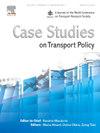Effects of meteorological factors on students’ commute to high school
IF 3.3
Q3 TRANSPORTATION
引用次数: 0
Abstract
Limited physical activity and a sedentary lifestyle are common among young people. The use of a bike sharing system (BSS) to commute to and from school seems to be a good way of promoting physical activity among students. However, choosing a means of transportation may be influenced by meteorological conditions. This study aimed to determine how meteorological conditions affect students’ use of BSS for commuting to and from high school. A self-organizing maps analysis was conducted to obtain information on the characteristics of the students’ daily commute. Use of the BSS and the meteorological condition of each day were selected as input variables. The Kruskal–Wallis test was used to determine the main effect of the cluster on the input variables. The results revealed six clusters (profiles) of days. Four clusters represented favorable meteorological conditions and higher BSS use. The remaining clusters grouped unfavorable conditions and lower BSS use. Comfortable temperatures (14.4–22.6 °C), low humidity, and light-to-moderate breeze (i.e. wind) had a positive influence on the use of the BSS by the students. Conversely, temperatures <14.2 °C and high humidity (>73 %) had a negative effect on the use of the BSS. Furthermore, rainfall had a nonlinear effect on the use of the BSS, whereas heavy precipitation had a negative effect on use of the BSS. However, light precipitation had no effect on BSS use. These findings indicate that meteorological conditions have a significant effect on the use of a BSS for active commuting to school by young students. Efforts should be made to provide better BSS infrastructure to encourage young people to use the BSS for active commuting.
气象因素对学生高中通勤的影响
体力活动有限和久坐不动的生活方式在年轻人中很常见。使用自行车共享系统(BSS)上下班似乎是促进学生体育活动的好方法。然而,选择交通工具可能会受到气象条件的影响。本研究旨在确定气象条件如何影响学生使用BSS往返高中。通过自组织地图分析,获得学生日常通勤特征的信息。选取BSS的使用情况和每天的气象条件作为输入变量。Kruskal-Wallis检验用于确定聚类对输入变量的主要影响。结果显示了6组天(剖面)。4个集群代表有利的气象条件和较高的BSS利用率。其余的组将不利条件和较低的BSS使用分组。舒适的温度(14.4-22.6°C)、低湿度和微风(即风)对学生使用BSS有积极的影响。相反,温度<;14.2°C和高湿度(> 73%)对BSS的使用有负面影响。降雨对BSS的利用具有非线性影响,而强降水对BSS的利用具有负向影响。轻度降水对BSS的利用无显著影响。这些结果表明,气象条件对青年学生使用BSS进行主动通勤有显著影响。应努力提供更好的BSS基础设施,鼓励年轻人使用BSS进行积极的通勤。
本文章由计算机程序翻译,如有差异,请以英文原文为准。
求助全文
约1分钟内获得全文
求助全文

 求助内容:
求助内容: 应助结果提醒方式:
应助结果提醒方式:


